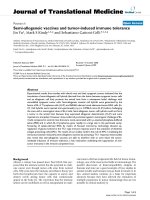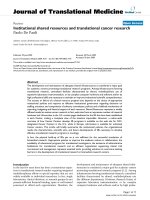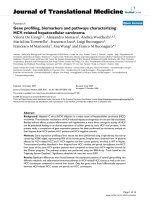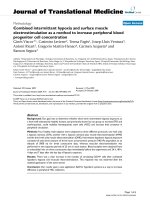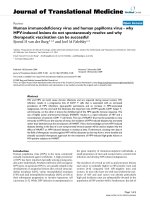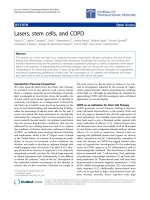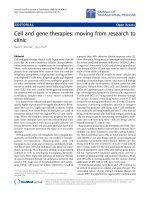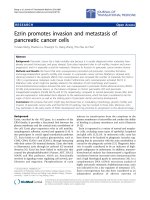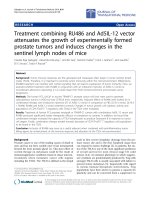Báo cáo hóa học: " 2DPCA fractal features and genetic algorithm for efficient face representation and recognition" pdf
Bạn đang xem bản rút gọn của tài liệu. Xem và tải ngay bản đầy đủ của tài liệu tại đây (576.19 KB, 7 trang )
RESEARCH Open Access
2DPCA fractal features and genetic algorithm for
efficient face representation and recognition
Yousra Ben Jemaa
*
, Ahmed Derbel and Ahmed Ben Jmaa
Abstract
In this article, we present an automatic face recognition system. We show that fractal features obtained from
Iterated Function System allow a successful face recognition and outperform the classical approaches. We propose
a new fractal feature extraction algorithm based on genetic algorithms to speed up the feature extraction step. In
order to capture the more important information that is contained in a face with a few fractal features, we use a
bi-dimensional principal component analysis. We have shown with experimental results using two databases as to
how the optimal recognition ratio and the recognition time make our system an effective tool for automatic face
recognition.
Keywords: face recognition, fractal coding, 2DPCA, IFS, genetic algorithms
I. Introduction
The human face is a very rich source of information that
can be used to identify persons. This ability of recognition
allows us to distinguish per sons despite the facial resem-
blance between them. Nowadays, many researchers try to
benefit from computer applications, which become widely
used in face automatic recognition.
After more than 30 years of research, we can classify
the different existing face recognition systems into th ree
main approaches.
• Loca l approaches which are based on the fact that
the face contains parts that have a high discriminating
power such as eyes, nose, mouth To recognize a per-
son, we use either the blocks containing these regions
or the geometric relationships between them [1,2].
Representative works include hidden Markov model
[3],
elastic bunch graph matching algorithm [4]
• There are global approaches which treat the face as
a whole object and use all the information included
in it. Many methods have been proposed that
include the use of Eigenfaces [5], discre te cosine
transform, and Gabor Wavelets [6] These methods
suffer from the size of the feature vector provided to
the classifier. For this reason, many linear and non-
linear methods for vector size reduction a re applied
(PCA, LDA, ICA, ).
• Hybrid approaches: The principle of these
approaches is to imitate the human visual system,
which u ses both local and global features to recog-
nize persons. The combination of these two methods
has only one interest: to take advantage of t he com-
bined benefits of both approaches [7,8].
Despite the number of researchers and the proposed
methods, several factors can significantly affect face
recognition performances, such as the pose, the pre-
sence/absence of structural components, facial expres-
sions, occlusion, and illumination variations.
In order to encounter these factors and ensure a high
recognition rate and a fast recognition time, we have
used, in this article, the fractal representation which
exploits the inter-image resemblance [9]. There are few
articles that are related to this topic [face recognition
using Iterated Function System (IFS) theory] [10-14]. A
description of some of these studies and their differences
from the proposed method can be found in Section 6.
The proposed system contains the following steps:
• Normalization of the original image.
• Feature extraction using fractal encoding of the
normalized image and genetic algorithm.
* Correspondence:
Signals and Systems Unit, National Engineering School of Sfax, Sfax
University, BP W 3038, Sfax, Tunisia
Ben Jemaa et al. EURASIP Journal on Information Security 2011, 2011:1
/>© 2011 Ben Jemaa et al; licensee Springer. This is an Open Access article distributed under the terms of the Creative Commons
Attribution License ( which permits unrestricted use, distribution, and reproduction in
any medium, provided the original work is p roperly cited.
• Application of the bi-dimensional principal compo-
nent analysis (2DPCA) technique on the fractal code
to reduce the feature vector dimension.
• Classification using Multi layer perceptron.
The idea proposed in this article has two major advan-
tages compared with the other approaches:
• Reduced size of the fractal code represents the fea-
ture vector. Since it has a reduced dimension, the
recognition can be ensured with satisfactory time. We
have proposed a new fractal algorithm based on
geneticalgorithmtoensurealowtimeforfeature
extraction step.
• High fidelity compared with the original image. The
fractal code represents discriminant features of the
original image. These feat ures are invariant over-
looked lighting, rotation, and translation of the face
and scaling, because the IFS theory takes into account
these variations.
We proposed to apply a 2DPCA to represent face by a
few fractal features having a high discriminatory power.
This article is organized as follows: Basic notions con-
cerning IFS, fractal coding theory and the new fractal
algorithm based on genetic algorithm are provided in
Section 2. Fractal features are presented in section 3. The
most discriminating fractal parameters extracted using
2DPCA are descr ibed in Section 4. Section 5 provides
face re cognition system b ased on neural ne tworks, the
experimental results and Comparison between the two
types of features obtained using IFS and PCA-IFS,
respectively. A comparison with other approaches is also
done in section 6. Conclusion and future works are pre-
sented in Section 7.
II. Genetic algorithm for fractal coding
A. IFS theory
The IFS theory is proposed by Barnsley, who suggested
that, instead of storing all the pixels of the still image, we
can keep only a collection of global cont racting tran sfor-
mations such as rotation and contrast scaling [15].
Image fractal encoding is well known in the literature. It
has been widely used for image compression [9,16]. In this
article, we have used it for classification purpose.
Firstly, the coding involves the partitioning of the image
into ra nges R
i
, which do not intersect and can have fixed
size or not (quadtree partitioning), an d domain D
i
which
can intersect . Secondly, we have searched the best range/
domain matching by applying a transformation W
i
to each
domain D
i
(see Figure 1).
This is possible because fractal coding is based on the
self-si milarity of the face, which means that regions can
be the transformed versions of some others like shown
in Figure 2.
Therefore, to code an ima ge, we need to determine a
set of R
i
, D
i
,andW
i
. To achieve an excellent coding
phase, we should make a good choice of transformation
W
i
between both R
i
and D
i
. Then, we have to find the
perfect adjustment of the contrast S
i
and the lighting O
i
for each W
i
using the method of least square [9].
B. The proposed algorithm
The major problem of standard fractal coding is time con-
sumption compared with other methods of image coding.
The time is essentially spent on the search of the similar
domain block. We present in this article, a new genetic
algorithm for image coding, that speeds up this method. In
the next, we have detailed our algorithm: the representation
of the fitness function , the Genetic operators and some
other improvements to the simple genetic algorithms.
There are many algorithms of optimization used for dif-
ferent domains. We have chosen genetic algorithm [17-19]
to accelerate our fractal image coding algorithm. We have
given details of genetic characteristics in the following
section.
1) Chromosome attributes
According to the regions parameter coding, a chromo-
some is constituted by N genes, where N is the number
of regions not yet coded.
Thegeneiscomposedofthreeparameters(X
Dom
,
Y
Dom
), that represent the domai n block coordinates and
the rotation W
i
. These three parameters are integers.
• X
Dom
Î [0, L], L is the image length.
• Y
Dom
Î [0, W ], W is the image width.
• W
i
Î [0, 7], eight possible rotations.
Figure 3 illustrates a chromosome representation.
2) Genetic operators
The crossover and mutation operators ensure the pro-
duction of offspring. These genetic operators must be
Figure 1 Range/Domain matching.
Ben Jemaa et al. EURASIP Journal on Information Security 2011, 2011:1
/>Page 2 of 7
defined according to the chromosome specification.
With these basic components, a genetic algorithm works
as follows: The first procedure is to generate the first
population represented with string codification (chro-
mosome) that represents possible solution to the pro-
blem. Each individual is evaluated, and according to its
fitness, an associated probability to be selected for
reproduction is assigned.
• The crossover operator combines two individuals
(the parents) of the current generation whose chro-
mosomes have not given selected solution to
produce two offspring individuals. According to our
chromosome specification, a new scheme of the
crossover operator is proposed. The offspring coor-
dinates and the isometric flip are selected randomly
from the parents as presented in Figure 4.
• Mutation operator modifies the chromosome genes
randomly according to the mutation probability.
Genes (X
Dom
, X
Dom
, W
i
) are changed with r andom
generated values, respectively, in [0, L], [0, W], and
[0, 7] intervals (see Figure 5).
3) Fitness measure
The fitness function assi gns to e ach individual in the
population a numeric value, that determines its quality
as a potential solution. The fitness denotes the indivi-
dual’s ability to survive and to produce offspring.
In our case, the fitness is the number of regions that
can be coded with root mean square error (RMSE)less
than a fixed value. The RMSE is the distance between the
region and the domain block is determi ned by its coordi-
nates (X
Dom
, X
Dom
) and transformed with corresponding
contrast S and the lighting O.
Figure 2 Inter image similarity.
Figure 3 Chromosome representation. Figure 4 Crossover operator scheme.
Ben Jemaa et al. EURASIP Journal on Information Security 2011, 2011:1
/>Page 3 of 7
The RMSE parameter is given in the following:
RMSE = ||S.D
i
− (R
j
− O)|
|
(1)
where||.||isthetwonormfunction,D
i
is domain
elements, R
j
denotes t he range elements, and valu es of
contrast S and lighting O are obtained when minimizing
the RMSE criterion (they are the two arguments that
minimize the RMSE).
4) Genetic coding algorithm
Geneticalgorithmshavebeenusedpreviouslytofind
solutions to the minimization problems related to the
fractal inverse problem [18]. Here, we describe the
Genetic Algorithm that we have used to speed up the
coding algorithm. This algorithm is used for all decom-
position schemes. In spite of the range block size and
position, the domain b lock is always do uble the size of
the range one.
The Algorithm
(Input I: NxN gray scale image [Image would be
square] Output W: Coded IFS);
(Region Size) = 16; (Fixed Error) = X;
Decompose the input image into (Region Size) blocks;
While Exist (Regions not coded)
Scale the Domain Blocks;
Generate a random population of chromosomes;
While Exist (Regions not coded) and (Last generation
not reached)
• Compute fitness for all regions;
• When optimal domain block found write obtained
transformation parameters to the output W;
• Generate new population Apply Crossover and
Mutation operators;
Wend
(RegionSize) = (RegionSize)/2;
If Regions size > 4
• Decompose the rest region not coded into (Range
Size) blocks;
Else
• (FixedError) = (FixedError) + X;
• Code all remaining Regions;
IEnd
Wend
III. Fractal features extraction
After fractal coding, where each domain is compared
with all regions of the image, we obtain a set of trans-
formations which can approximate the face image. Each
transformation is represented by parameters of contrast
S
i
,brightnessO
i
, s patial coordinates of Range/Domain,
and rotation W
i
(seven parameters). The size of the
obtained feature matrix is equal to 7× the number of
transformations necessary to code all regions. So redu-
cing the size of the information is necessary for mini-
mizing the recognition time. An immediate reduction of
the feature vector consists of replacing the coordinates
of the regions and domains by two normalized dis-
tances:
• x: the distance between the Domain D
i
and the
region R
i
according to the abscissas,
• y: the distance between the Domain D
i
and the
region R
i
as the ordinates.
Thesizeofthenewmatrixisthenequalto5×the
number of transformations.
Despite all the reductions of the fractal vector, it
remains quite large. Thus, we propo sed to use a two-
dimensional PCA to extract the most discriminating
features.
IV. The discriminating parameters of fractal
features
The 2DPCA is a method of data analysis, based on find-
ing a new ref erence on which we represent the informa-
tion while keeping only discriminating data [20]. As
opposed to conventional PCA, 2DPCA is based on
matrices rather than vectors. Consequently, the covar-
iance matrix can be constructed directly using original
matrix of features. So, when using 2DPCA, it is easier to
evaluate the covariance matrix, and less time is required
to determine the corresponding eigenvectors.
The idea consists of projecting each feature matrix X
(n × m) through a linear transformation.
Figure 5 Mutation operator scheme.
Ben Jemaa et al. EURASIP Journal on Information Security 2011, 2011:1
/>Page 4 of 7
The first step is to calculate the covariance matrix G
t
of fractal features which is obtained from the images of
the training database as follows:
G
t
=
1
M
(X
j
−
ˆ
X)
T
∗ (X
j
−
ˆ
X),
(2)
where M is the number of images in the database, X
j
represents the fractal matrix obtained from the image
number j of the training database, and
ˆ
X
is the average
of all fractal matrices associated to the images from the
training database.
The next step is to choose d eigenvalues associated
with eigenvectors obtained from the previously calcu-
lated covariance matrix. These eigenvalues determine
the new reference that minimizes the criterion J (R)
defined by:
J
(R)=R
T
∗ G
t
∗ R
R
T
i
R
j
=0,i = j,i, j =1, ,
d
(3)
The third step is to extract the main features of X as
follows:
Y
=
X
∗
R
(4)
where R =[R
1
R
2
R
d
] is the projection matrix and Y
=[Y
1
Y
2
Y
d
] is the fractal feature matrix produced
after applying 2DPCA.
To project the matrix in the new base, we have selected
the eigenvectors associated with the largest eigenvalues.
The biggest shortcoming of 2DPCA is the choice of the
number of retaine d eigenvalues. To solve this problem,
researc hers have adopted different solutions, either heur-
istically [21] or graphically according to the shape of
eigenvalues [22]. In this article, we used a graphically
method to select the most important eigenvectors.
V. Experimental results
A. Overview of the used face databases
To highlight the performances of t he proposed system,
we have carried out the first experiment on the Yale
database [23], with the aim of pinpointing the behavior
of our approach under changing face expressions and
poses. This base contains 165 images of 15 individuals.
In this experiment, 30% of all image samples per class
are chosen randomly and are use d for training, and the
remaining images for te st. The proposed approach has
also been applie d on the ORL database [24], which con-
tains 10 diffe rent images of each of the 40 distinc t indi-
viduals. For this database also, 30% image samples per
class are chosen randomly, a nd are u sed for training
and the remaining images for test. In the ORL database,
images a re taken at different lightin g conditions, facial
expressions, and orientations which allows testing the
behavior of our approach under these changes.
B. The classification system
The face recognition was ensured by a multilayer per-
ceptron architecture. The training of weights is assured
by the algorithm of retro-propagation. This architecture
is the most use d one be cause it can reduce miss-classifi-
cation among the neighborhood classes.
C. Face recognition using fractal features
In order to have fractal fe ature vectors w ith the same
length, the size of the face must be normalized (32 ×
32). The normalized image is coded by 64 transforma-
tions using fractal code. Consequently, we obtained 320
fractal features as each transformation is coded on 5
parameters, as already explained in Section 3.
Table 1 shows the performance of our system using
fractal features for the two databases. Each of the recogni-
tion rate has been tested on five random combination of
the face samples. According to these observations, fractal
features gave very good results.
D. Face recognition using 2DPCA-IFS features
Given the large number of the used parameters (320
parameters), our idea was to apply a bi-dimensional
PCA on the fractal features for the two already-men-
tioned databases. After a 2DPCA was applied on all fea-
tures matrices, we were able to achieve the following
results found in Table 2.
Westudyheretherelationbetweenthenumberof
transformation used as features and the recognition rate.
We have found that recognition rate grows u ntil trans-
formation number reaches a value about 5, and then it
remains almost constant as transformation number con-
tinues to grow. Consequently, the compromise r ecogni-
tion r ate/transformation (the optimal situation is given
with the minimum number of transformation and a
satisfactory recognition rate) number is solved for five
eigenvectors for the two databases. This can be
explained according to the variation of the eigenvalues.
We can keep until the fifth eigenvalue and the remain-
ing eigenvalues can be neglected as shown in Figure 6.
Here, we preserve all the five parameters for each trans-
formation, for the two databases.
From the previous analysis, we can notice that the
best choice to keep is five transformations where each
one is coded by five parameters to ensure a good recog-
nition phase.
Table 1 Recognition rate using fractal features
Database Recognition rate
Yale 99.16
ORL 98.33
Ben Jemaa et al. EURASIP Journal on Information Security 2011, 2011:1
/>Page 5 of 7
E. Comparison between IFS and 2DPCA-IFS features
In Table 3, we present the recognition rate obtained,
when using all fractal features, and those reduced by the
2DPCA with the optimal configuration (five transforma-
tions where each one is coded by five parameters). While
comparing the two methods, we can deduce those recog-
nition rates that were found using the two databases
which did not decrease significantly.
The major advantage of 2DPCA-IFS method is that the
number of parameters decreases from 320 parameters
with IFS to only 25 parameters with 2DPCA-IFS, which
can reduce the recognition time while keeping a very
satisfactory recognition rate.
VI. Comparison with other approaches
Here we compare our results with earlier results pub-
lished in [10-12]. ORL database is used for comparison.
The FND method [10] consists of three steps:
• A standard fractal coding giving a code for each
image in the database.
• Each image I is decoded with each code in the
database to generate the output image called the
attractor.
• A classification step for each test image I using the
minimization of FND distance d
FN
(fractal neighbor
distance) defined as the distance between the test
image and the attractor image:
d
FN
= d(f
j
(I), I)
,
(5)
where f
j
is the jth fractal code in the database, f
j
(I )is
the decoded image using the code f
j
.
The LR-SNN-T method [11] is based on an equaliza-
tion of the original image and a normalization of its
dimension using a bicubic interpolation. The feature vec-
tor is represented by the whole image after processing.
The classification is achieved by a multilayer perceptron.
Finally, the X method [12] consists on extracting parts
of face, containing the most discriminating information
like eyes, nose Then applying a standard fractal coding
on ea ch detected part, the c lassification is also ensured
by a multilayer perceptron.
Although both approaches, the FND and X, use the
IFS coding, they ar e completely different from our
approach. This difference is summarized in Table 4.
The performance comparison between all approaches
is shown in Table 5 and Figure 7.
We conclude that
• Fractal features are much more powerful than
others and are good means to characterize faces.
• Five eigenvalues are sufficient to code faces. A little
improvement is observed when more than five
eigenvalues are used.
• The robustness of our 2DPCA-IFS approach is that
it gives the best time recognition, and thanks to the
use of genetic algorithm and 2DPCA technique,
Table 2 Recognition rate versus the number of
transformations
Number of transformations RR(Yale) RR(ORL)
2 66.67 42 .33
5 98.15 97.15
8 98.15 97.29
12 98.67 97.29
15 98.67 97.54
30 98.67 97.66
45 98.83 97.66
60 98.83 97.67
Figure 6 Eigenvalues representation in descending order.
Table 3 Recognition rate for the two approaches and the
two databases
Approach Yale ORL
IFS and GA 99.165 98.33
2DPCA-IFS and GA 98.15 97.15
Table 4 Differences between our approach and other
approaches
Approach FND X Our approach
Technique used
for feature
extraction
Standard
fractal
decoding
Standard fractal
coding applied in
facial regions
Genetic
algorithm for
fractal coding
Classification FND
distance
MLP MLP
Databases used
for evaluation
ORL-Yale ORL–In room
database
ORL–Yale
Ben Jemaa et al. EURASIP Journal on Information Security 2011, 2011:1
/>Page 6 of 7
which keeps a high recognition rate proving its
applicability for real time system.
VII. Conclusion
A hybrid approach is introduced in which, through the
2DPCA, the most discriminating genetic fractal features
are extracted and used as the input of a neural network.
The performance of our method is both due to the
fidelity of fractal coding for representing images, the
genetic algorithm to speed up the features extraction
step, and the 2DPCA which hig hlights all discriminating
features.
Compared with other approaches, the proposed recog-
nition method has achieved high recognition rate and
low recognition time for the two databases.
Abbreviations
2DPCA: bi-dimensional principal component analysis; IFS: iterated function
system.
Competing interests
The authors declare that they have no competing interests.
Received: 15 November 2010 Accepted: 23 August 2011
Published: 23 August 2011
References
1. Ben Jemaa Y, Khanfir S: Automatic local Gabor features extraction for
face recognition. Int J Comput Sci Inf Secur 2009, 3(1):116-122.
2. Cox IJ, Ghosn J, Yianilos PN: Feature-based recognition using mixture-
distance. IEEE Conference on Computer Vision and pattern Recognition 1996,
209-216.
3. Nefian AV, Hayes MH: An embedded HMM based approach for face
detection and recognition. IEEE International Conference on Acoustics,
Speech and Signal Processing 1999, 6:3553-3556.
4. Wiskott L, Fellous JM, Kruger N: CVD Malsburg, Face recognition by elastic
bunch graph matching. Intelligent Biometric Techniques in Fingerprint and
Face Recognition 1999, Chapter 11:355-396.
5. Moon H, Philips PJ: Computational and performance aspects of PCA
based face recognition algorithms. Perception 2001, 30:303-321.
6. Hang HZ, Zhang B, Huang W, Tian Q: Gabor wavelet associative memory
for face recognition. IEEE Trans Neural Netw 2005, 16(1):275-278.
7. Zhao W, chellappa R, Phillips PJ, Rosenfeld A: Face recongnition: a
literature survey. ACM Comput Surv 2003, 35(4):399-458.
8. Chen CJ: Integration of local and global features for face recognition.
International Conference on Neural Networks and Signal Processing 2008,
193-198.
9. Wohlberg BE, De Jager G: A review of the fractal image coding literature.
IEEE Trans Image Process 1999, 8(12):1716-1729.
10. Tan T, Yan H: Object recognition based on fractal neighbor distance.
Signal Process 2001, 81:2105-2129.
11. Zeb J, Javed MY, Qayyum U: Low resolution single neural network based
face recognition, in Proceedings of World Academy of Science.
Engineering and Technology 2007, 22.
12. Temdee P, Khawparisuth D, Chamnongthai K: Face recognition by using
fractal encoding and backpropagation neural network. International
Symposium on Signal Processing and its Applications, Brisbane, Australia 1999.
13. Abate AF, Nappi M, Riccio D, Tucci M: Occluded face recognition by
means of the IFS. Lecture Notes in Computer Science 2005, 3656.
14. AF, Nappi M, Riccio D, Tortora G: An IFS based approach for face
recognition. IEEE ICIP 2005, 2.
15. Barnsley B, Hurt L: Fractal Image Compression. Peters, Wellesley; 1993.
16. Fisher Y: Fractal Image Compression with Quadtrees. book Springer-
Verlag London, UK; 1995.
17. Goldberg DE: Genetic Algorithms in Search, Optimization, and Machine
Learning.
Addison Wesley Publishing Company; 1989.
18. Shonkwill R, Mendivil F, Deliu A: Genetic algorithms for the 1-D fractal
inverse problem. Proceedings of the Fourth International Conference on
Genetic Algorithms, San Diego 1991.
19. Wu M-S, Teng W-C, Jeng J-H, Hsieh J-G: Spatial correlation genetic
algorithm for fractal image compression. Fractals 2006, 28(N 2):497-510.
20. Yang J, Zhang D, Frangi AF, YuYang J: Two-dimentional PCA: a new
approach to appearence-based face representation and recognition. IEEE
Trans Pattern Anal Mach Intell 2004, 26:131-137.
21. Turk MA, Pentland A: Face recognition using eigenfaces. IEEE conference
on Computer Vision and Pattern Recognition 1991, 586-590.
22. Turk MA, Pentland AP: Eigenfaces for recognition. J Cogn Neurosci 1991,
3(1):71-86.
23. Georghiades A, Kriegman D, Belhumeur P: From few to many: generative
models for recognition under variable pose and illumination. IEEE Trans
Pattern Anal Mach Intell 2001, 40:643-660.
24. ORL Face Database. [ />facedatabase.html].
doi:10.1186/1687-417X-2011-1
Cite this article as: Ben Jemaa et al.: 2DPCA fractal features and genetic
algorithm for efficient face representation and recognition. EURASIP
Journal on Information Security 2011 2011:1.
Submit your manuscript to a
journal and benefi t from:
7 Convenient online submission
7 Rigorous peer review
7 Immediate publication on acceptance
7 Open access: articles freely available online
7 High visibility within the fi eld
7 Retaining the copyright to your article
Submit your next manuscript at 7 springeropen.com
Table 5 Recognition rates/times for different methods
Approach IFS IFS and
GA
2DPCA-IFS
and GA
FND LR-SNN-T X
Recognition
rate
98.4 98.33 97.15 95.25 90.25 85
Recognition
time (S)
7.59 1.75 1.41 9.1 38.12 n/a
Figure 7 Recognition rates/times for different methods.
Ben Jemaa et al. EURASIP Journal on Information Security 2011, 2011:1
/>Page 7 of 7
